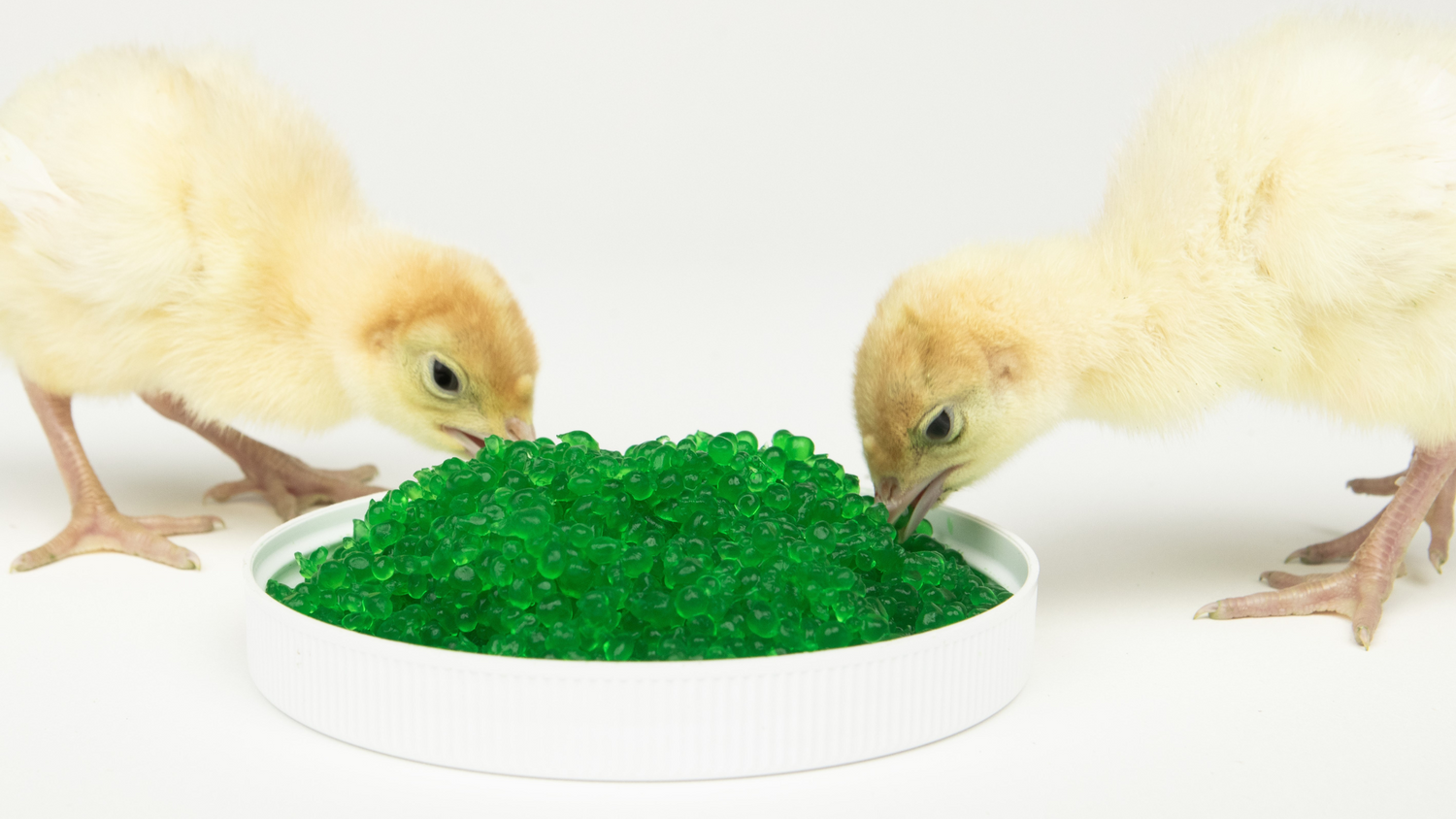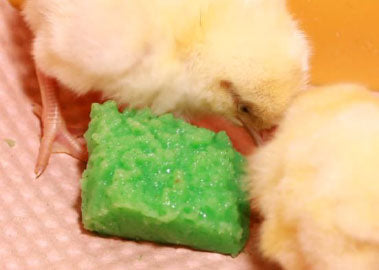Background
The sooner hatchlings discover and start consuming feed and water at placement, the quicker their digestive and immune systems will develop and provide a foundation for strong growth. The key metrics for poultry producers for early performance – 24-hour crop fill, feeding behavior, and 10-day performance, and overall livability – are positively impacted by proper hydration and nutrition provided by early access to feed and water.
Poultry producers through the years have experimented with various feed attractant products including green-dyed crack corn made on the farm to commercially available Oasis® which has since ceased from being manufactured. Recently, a new product based on innovative gel technology, AquaBeads® (ClearH2O Inc.) has been introduced to commercial poultry producers. AquaBeads® is a water gel bead enhanced with electrolytes and betaine to provide both hydration and nutrition supplementation when applied as a feed attractant top-dressing at that time of placement. AquaBeads® are highly attractant and translucent green gel beads ranging in size from 2-5mm.
Experimental Design
At day of placement, 720 turkey poult hens were neck tagged, individually weighed, and randomly allocated to one of three treatment groups: 1) a non-treated control that did not receive AquaBeads® supplementation, 2) a group that received AquaBeads® supplementation, or 3) a group with the ability to frequent a feed flat with or without AquaBeads® supplementation as a preference. Poults were placed on fresh pine shavings in 4x4ft. floor pens. Each pen had two feed flats with or without AquaBeads® supplementation. Individual body weights were recorded at placement and at day 10 to evaluate body weight gain.
Experimental Groups
| Group | Treatment¹ | Feed flats with AquaBeads®/total feed flats/pen | Replicate pens/treatment | n/pen |
| 1 | Non-treated control | 0/2 | 8 | 30 |
| 2 | AquaBeads® | 2/2 | 8 | 30 |
| 3 | AquaBeads® Preference | 1/2 | 8 | 30 |
¹AquaBeads® provided on top of feed flat at ~1-1.5g/poult. Single application immediately prior to placement.
Two cardboard feed trays (14” W x 22” L x 2” H), each containing 1.5kg of turkey starter feed, were situated similarly in each pen. AquaBeads® were added on top of the feed immediately prior to placement. Based off a preliminary study, AquaBeads® were provided at 1.5g/poult or 45g/pen. The AquaBeads® group received the treatment evenly allocated across both feed flats (22.5g/flat). However, the AquaBeads® preference group had one feed tray containing the full 45g AquaBeads® treatment and one feed flat that contained feed only. To prevent unduly influencing the bird’s choice of feed flat, poults were placed equidistant from both feed trays.

Results
At placement (d0), there were no significant differences in average body weight (BW) between treatments. However, at d10, AquaBeads® and AquaBeads® preference had significantly (P<0.05) greater average BW compared to the non-treated control. Average BWG from d0-10 was also significantly higher in the AquaBeads® and AquaBeads® preference groups compared to the nontreated control. While there were no significant differences in FCR between all groups, there was a numerical improvement associated with AquaBeads® supplementation compared to the non-treated control. For example, a 5-point reduction in FCR was observed for the AquaBeads® group (FCR 1.83 ± 0.06) and a 9-point reduction was observed for the AquaBeads® preference group (FCR 1.79 ± 0.02) compared to the non-treated control (FCR 1.88 ± 0.05).
TABLE 1. Effect of AquaBeads® supplementation on 10-day performance parameters in turkey poults.
| Group | Average BW (g) d0 | Average BW (g) d10 | Average BWG (g) d0–d10 | FCR (mortality-adjusted) d0–d10 | Mortality (%) d0–d10 |
|---|---|---|---|---|---|
| Non-treated control | 52.87 ± 0.26 | 118.16 ± 1.75ᵇ | 65.19 ± 1.73ᵇ | 1.88 ± 0.05 | 8/240 (3.33) |
| AquaBeads® | 52.49 ± 0.26 | 124.44 ± 1.65ᵃ | 72.08 ± 1.61ᵃ | 1.83 ± 0.06 | 5/240 (2.08) |
| AquaBeads® preference | 52.90 ± 0.26 | 124.29 ± 1.63ᵃ | 71.36 ± 1.63ᵃ | 1.79 ± 0.02 | 12/240 (5.00) |
| P-value | 0.462 | 0.011 | 0.006 | 0.324 | NS¹ |
- ᵃ,ᵇ Superscripts denote significant differences across treatment groups within a column.
- ¹NS = no significant differences observed for mortality between treatment groups (Chi-square).
- BW, BWG, and FCR data are expressed as mean ± standard error.
- Statistical analysis performed with ANOVA (JMP Pro 16). Means were further separated using Tukey HSD.
Results Summary
BW (d10) and BWG (d0-10)
Average BW at d10 and BWG from d0-10 were both significantly (P<0.05) higher in the AquaBeads® and AquaBeads® preference groups compared to the nontreated control. The consumption of AquaBeads® did not negatively affect BW at d10 or BWG from d0 10 during the course of this trial.
FCR
There were no significant differences in FCR between all groups from d0 to d10. However, there was a numerical improvement associated with AquaBeads® supplementation compared to the non-treated control. The addition of AquaBeads® to both feed flats resulted in a 5-point improvement in FCR (FCR 1.83 ± 0.06) compared to the nontreated control (FCR 1.88 ± 0.05). A 9-point improvement in FCR was observed for the AquaBeads® preference group (FCR 1.79 ± 0.02) compared to the non-treated control. The consumption of AquaBeads® did not negatively affect FCR from d0-10 during the course of this study.
Crop Fill
At 15- and 45-minutes post-placement there was evidence of both feed and AquaBeads® product in the crop and gastrointestinal tracts of both AquaBeads® treatment groups. The consumption of AquaBeads® did not negatively affect 24h crop fill assessment.
Conclusion
At the time of placement, turkey poults found and consumed AquaBeads® without being prompted. The consumption of AquaBeads® did not negatively affect BW at d10, BWG from d0-10, 24h crop fill, of d0-10 FCR during the course of this trial. Future research should be conducted to validate these results and to assess the effect of AquaBeads® supplementation on long-term performance in commercial turkeys in a controlled, laboratory setting. A field study would provide useful information regarding AquaBeads® supplementation in a commercial setting.

This research study was conducted at the University of Arkansas, Department of Poultry Science by Danielle Graham, Ph.D., Assistant Professor – Parasitology; Shawna Weimer, Ph.D., Assistant Professor, Director of the Center for Food Animal Wellbeing; and Aaron Forga, B.S., Poultry Science Program Technician.




Leave a comment
All comments are moderated before being published.
This site is protected by hCaptcha and the hCaptcha Privacy Policy and Terms of Service apply.